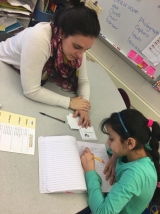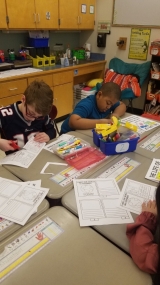-
Category 2
Selected in 2016
-
Grades: pre k - 4
School Setting: urban
Town Population: 110
Student Enrollment: 503
Student Demographics:
Black/African American: 6.4%
Teacher/Student Ratio: 1:14.7
White/Caucasian: 41.9%
Hispanic: 25.6%
Hawaiian/Pacific Islander: 0%
Asian: 20.7%
Native American: 0.2%
Other: 5.2%
% Reduced Lunch: 41.9%
% ELL Learners: 24.7%
Founded: 1966 -
PRINCIPAL:
Mathew McLean -
CONTACT:
425 West Meadow Rd
Lowell, MA 01854
617-530-0520
mmclean@lowell.k12.ma.us
Pawtucketville Memorial Elementary School
Lowell, MA
One major element to this work was helping staff and students learn to “have fun”... at school, because a place where people laugh, smile, and have fun is a place where people want to be.
- Describe specific programs in place to ensure that families are involved in the success of your school and students.
- Pawtucketville has a PTO and a School Site Council that meets monthly. In addition, the school hosts numerous family events throughout the year that have become ingrained traditions for the community. These events are designed to connect students to their schools, are held once a month and are very well attended. The most popular traditions include our pancake breakfast and our pasta supper. We also host a math night, a Bingo for Books event and Scary Story night--to name a few more. We also invite parents to our monthly All School Assemblies where we honor students that demonstrate character traits consistent with our school values such as perseverance and teamwork. Each assembly includes a musical performance from a grade level which helps draw families in.
- Describe the most successful activity your school has initiated to strengthen ties to your community.
- One of the reasons Pawtucketville School had such a powerful turnaround was because we actively reached out to our parents to find ways to effectively involve them at the school and gain input in how to better meet the needs of the school. Actually using Title 1 funding to help us secure an effective Parent Liaison position at the school was a critical element of the turnaround process. However, equally important as the funding was for the position was the fact that we searched for several years until finally finding the right person for the job who could make a strong connection from the school out into the community. Once this bridge was established, our parents were much more comfortable interacting with the school, advocating for the needs of their children, and supporting the work we were doing. It resulted in a revamped and far more effective PTO, but more importantly helped the parents to better understand and support the work we were doing on a daily basis with their children.
- Describe your philosophy of school change or improvement.
- School change involves a combination of principal leadership and teacher empowerment. A strong school is not defined by one leader. Rather, a school needs to be conceptualized as a living academic institution where stakeholders become committed to certain principles. In this model, the school principal acts as a shepherd that directs the staff toward defining the principles and then holds individuals and teams accountable for embodying them. Twenty-first century education requires teamwork and it is essential that teachers feel empowered to make curriculum decisions as a team. School improvement occurs when a successful balance of principal leadership and teacher empowerment is maintained.
- What are your school’s top two goals for the next year?
- Our school has four goals that are clearly defined. In english language arts, we are focusing on attending to vocabulary. We are working together to focus on precision in math. Our staff culture goal involves attending to conflict openly, honesty and directly. Finally, our student goal involves using principles of yoga to attend to mindfulness.
- What is the single most important factor in the success of your school that others could replicate?
- The most successful factor that needs to be replicated is building and maintaining a professional culture that is positive and strikes a healthy balance between administrative leadership and teacher empowerment.
- Describe the program or initiative that has had the greatest positive effect on student achievement, including closing achievement or opportunity gaps, if applicable.
- There is no question that the data-analysis, coaching, and collaboration established at the school had a profoundly positive impact on student achievement and closing the achievement gap. However, the initiative or approach that had the greatest positive impact overall was deconstructing the negative, toxic behavior and mentality that was the face of the school and replacing it with positive and solution-focused voices within the building. Once the negative voices were marginalized and the voices of positivity became the majority, everyone in the building began to “jump on board”. Turnaround only happens when everyone in the school is taking accountability for the work and understands how important they are to the overall success. Beyond all of the instructional and curricular changes, what had the greatest impact on the school was the change in mentality, because the new positive mindset caused more and more people to “jump on board” with the amazing work that was being done.
- Explain how Title I funds are used to support your improvement efforts.
- As a result of some creative and effective organization and support from our nationally recognized Title 1 director, our school’s Title 1 funds have historically gone to support a tutor, a full-time social worker, and a part-time parent liaison. While the tutor has absolutely helped support the academic work done, the social worker and the parent liaison have had a significant impact on the overall culture at the school. The parent liaison has allowed Pawtucketville School to establish a bridge into the community to tap into the parents as a resource for school improvement. The social worker has allowed us to work to directly address the growing mental health needs of our student population. Both of these assets at the school were absolutely essential in the overall turnaround at the school and both were completely funded by Title 1 funding of our school.
- Identify the critical professional development activities you use to improve teaching and student learning.
- The most important professional development activity is one that requires collaboration and common learning. There is an infinite amount of high-leverage learning a teacher can focus on. The topic we choose as a school is arguably less important than the staff working together to identify a focus and then commit to learn together. Professional development will only be successful if most teachers believe in the work and recognize that they can learn more together rather than independently. Each year the various academic and culture teams analyze data and select one goal for math, ELA, staff culture and student culture. We learn together and from each other’s successes and failures.
- Describe how data is used to improve student achievement and inform decision making.
- At the cornerstone of our success has been consistent, methodical, and insightful data analysis. Within the first two years of the turnaround our school had adopted and fully implemented a data analysis program that included both vertical and grade-level teams. The data was collected, organized, and analyzed to help the school honestly identify their areas of need in order to make instructional and curricular adjustments. The data collection was ongoing in an effort to constantly be refining, reshaping, and improving our instruction to meet the specific needs of the students that were emerging from the data. The school used those data analysis structures to design coaching and collaborative structures at the school to help not only address our areas of weakness, but to continue to support our relative areas of strength. Part of the engrained culture now at Pawtucketville is that data is an essential and integral component of our instructional and curricular decision-making process.
- Describe your school culture and explain changes you’ve taken to improve it.
- We built our school on the concepts or determination, perseverance, and resiliency with the expectation that everyone who was a part of our community embodied those three characteristics. The culture is one that challenges and holds accountable not only our students, but also our staff. Through coaching models focused on improving instruction, collaborative structures being designed and implemented, and helping everyone simply learn to have fun at work, our culture became one where people are excited and motivated. This was not always the case at Pawtucketville School and there had to be significant changes made to the overall attitude and general morale in the building. This change was made by a balanced approach of working to refine instruction and build a positive culture of respect. One major element to this work was helping staff and students learn to “have fun” again at school, because a place where people laugh, smile, and have fun is a place where people want to be.
Stats
-
Category 2
Selected in 2016
-
Grades: pre k - 4
School Setting: urban
Town Population: 110
Student Enrollment: 503
Student Demographics:
Black/African American: 6.4%
Teacher/Student Ratio: 1:14.7
White/Caucasian: 41.9%
Hispanic: 25.6%
Hawaiian/Pacific Islander: 0%
Asian: 20.7%
Native American: 0.2%
Other: 5.2%
% Reduced Lunch: 41.9%
% ELL Learners: 24.7%
Founded: 1966 -
PRINCIPAL:
Mathew McLean -
CONTACT:
425 West Meadow Rd
Lowell, MA 01854
617-530-0520
mmclean@lowell.k12.ma.us








